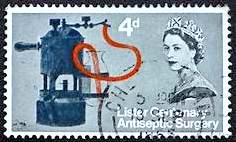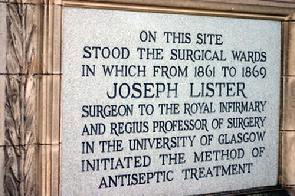Joseph Lister was a British surgeon who introduced new principles for cleanliness in the medical world which transformed surgical practices in the late 1800s. He introduced antiseptic method that increased the safety in operations and laid the foundations for all the subsequent advances in surgery.
His principle was that bacteria must never gain entry to an operation. This is still the basis of surgery even now and has saved countless lives.

Family and Life of Joseph Lister
Joseph Lister was the fourth amongst the seven children of the wine merchant and opticist Joseph Lister. He was born on 5th of April 1827 and his birthplace was West Ham in England. Lister’s father, himself an expert microscopist, had encouraged him to use a microscope from boyhood.
He went on to read classics, mathematics and natural philosophy for his degree; but he already had his eye on his future, for he was present in 1846 when the first major operation in Europe took place under anesthetic just across the road, in University College Hospital
Continuing his studies in London, Lister passed his exams, and became a fellow of the Royal College of Surgeons in 1852. He qualified in three years instead of the usual four amd then took up his first appointment as a “clinical clerk” at the hospital, while continuing to do original research of his own.
His work on the microscopic structure of muscle produced his first two publications in 1853. In May of that year, he was officially awarded the Bachelor of Medicine degree. By then he had been at University College for the unusually long period of ten years, and it had had a profound influence on his career.
He was recommended to visit Professor of Clinical Surgery James Syme (1799-1870) in Edinburgh and became his dresser, then house surgeon and then his son-in-law after marrying his eldest daughter Agnes.
The background behind Joseph Lister’s discovery
In those times bed linens and lab coats were unclean with no washing before a surgery. Cleaning of surgical apparatus was done only before putting away for storage. Same probes were used for the wounds of all patients checking for pockets of undrained pus.
In those days Suppuration and laudable pus were thought to be a normal healing process. A common surgical report was “operation successful but the patient died”. Approximately 1 in 4 patients died on surgical wards from infection, and all surgical wards were recognizable by the smell of putrefaction.
So thoughts of banning all surgery from hospitals due to septic complications were under consideration.
Lister changed medicine forever by getting other surgeons to understand that germs spread disease but that they could something about it. Lister got interested in wound healing while working as a dresser for Sir Erichsen.
Erichsen’s belief was that, wounds were infected from bad air or miasmas that arose from the wounds and became concentrated in the air. Erichsen’s deduction was that with more than 7 patients with an infected wound in a 14-bed ward would result in saturation of the air, spreading the dangerous gasses and cause gangrene.
When the wounds were debrided and cleaned, only some wounds would heal. He suspected this and gradually concluded that something was at fault in the wound itself.
Joseph Lister’s Invention
Joseph Lister read the work of Louis Pasteur about fermentation of beer and milk being due to some micro-organisms. He then realized that this might also be the cause of putrefaction or decay in wounds.
After learning that authorities in Carlisle were using creosote to treat smelly sewage, which had not only reduced the odor, but reduced disease among cattle and humans he came to know about the active ingredient, carbolic acid and started his series of experiments.
He used dressings soaked with carbolic acid (phenol) to cover the wound observing that the infection was greatly reduced. Lister also experimented with hand-washing, sterilization of instruments and using spray of carbolic in the theatre while operating.
Instruments were also washed in the 5% carbolic acid solution and assistants sprayed the solution in the operating theatre. One of his interesting suggestions was to avoid use porous natural material in manufacturing the handles of medical instruments. Lowering of infection was very good and Listerian principles were adopted throughout many countries by a number of surgeons.

Joseph Lister Facts
To Lister’s satisfaction, not only were the surgical patients helped by germ-free healing, but the environment in hospital as a whole also improved. It had such a profound impact that he said the dreaded so-called “hospital diseases” had vanished from his wards. On the zenith of his success, in 1869 Lister became the Professor of Clinical Surgery at Edinburgh.
It was reported that his surgical wards had remained free of sepsis. To put some numbers to the success, from 1864 and 1866, before the use of antiseptic treatment, 46% of Lister’s surgical patients died. Whereas, from 1867 to 1870, only 15% died.
Criticism
When Lister showed that the surgeon should be and was responsible for the effects of the operation, it caused annoyance of many surgeons as they could no longer avoid their responsibility. They felt that Lister was endeavoring to place unnecessary heavy burden upon them lent vindictiveness to their opposition.
People also found it hard to believe when this young guy said, there are these invisible creatures and you can’t see them with your eye but they’re killing your patients. His critics listed the use of carbolic acid as posing respiratory and visual problems.
People mane fun of his methods and labelled them as a waste of time and money. In 1873, a journal expressed that the whole medical world was against his ideas. Still, he had many supporters as well.
He pioneered not only use of antiseptics but also of various important and life-saving surgical techniques (including the use of dissolving ligatures and drainage tubes), Lister was a major force in the transformation of surgical practice and success rates during his times
Achievements of Joseph Lord Lister
Being a professor at King’s and a Consulting Surgeon to King’s College Hospital, from 1878 he was “Surgeon in Ordinary” to Queen Victoria. In 1879 he received a rousing ovation at the International Medical Congress in Amsterdam, a sign of the growing recognition of his work abroad.
In 1881 he was elected President of the Clinical Society of London and also became President of the Royal Society in 1883, and a peer in 1897. For the last two years of her life, he was “Serjeant-Surgeon” to the Queen, at her own insistence, and he was one of the original recipients of the Order of Merit in 1902.
In 1903, the name of the British Institute of Preventative Medicine, which he had been instrumental in founding, was changed from the Jenner Institute to the Lister Institute.

Listerine, Mountain Name, and Joseph Lister
Lister’s work was an inspiration to others. Joseph Lawrence, a chemist living in Missouri, developed an alcohol-based formula for an antiseptic mouthwash in 1879 that he named ‘Listerine’ in his honour which is sold till day.
You might have used this popular mouthwash Listerine—which is promoted with the slogan “Kills germs that cause bad breath”
Lister has public monuments and hospitals dedicated to him around the world. In Antarctica, you may also see a massive mountain named in his honor: At around 13,200 feet, Mount Lister is the highest point in the Royal Society Range, a mountain range in Victoria Land, Antarctica.

How Did Joseph Lister Die?
He did not like much to be in limelight. After his wife’s death in 1893 during their trip to Italy, he retired from practice. He died at the age of 84 on 15th Feb 1912 due to declining health at Kent, England where he had spent last years of his life.
We take it for granted that a surgeon will guard a patient’s safety by using aseptic methods. But this was not always the case, and until Lister introduced sterile surgery.
He is rightly remembered as “father of antiseptic surgery” in honour of his remarkable accomplishments.
